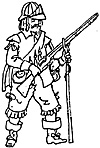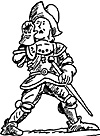 The tricky part is developing rules to allow men on land and in boats to fight side by side. My rules are a first draft, not a tested and refined system. Do you have any helpful ideas?
The tricky part is developing rules to allow men on land and in boats to fight side by side. My rules are a first draft, not a tested and refined system. Do you have any helpful ideas?
Weapons
There is no hand-to-hand combat. Missile weapons have the same range and effect when used from a boat as on land. This applies to cannon, crossbow, musket, throwing spear, bow and arrow, slings and thrown rocks. Wooden walls on Spanish boats count as walls on land and count in modifying hit chances. Ditto for Aztec shields.
Moves
The wind may be a factor, but most pictures show the Spanish attacks were made with the wind at their backs. Spanish boats move with the wind at a rate equal to that of cavalry on land. Crossing the wind or into it, they move at the rate of heavy infantry on land. They may turn up to 90º in one move. Aztec boats and allied canoes move at the speed of light infantry in any direction. They can turn up to 180º in one move. Spanish boats may run aground in shallow water. Roll a D-6 each turn. A roll of 1 is grounded. After that a roll of an even number on D-6 enables the boat to get afloat again. If a Spanish ship goes into an area with sharpened stakes, it is impaled and cannot move unless they roll a 5 or 6 on a D-6. If the roll produces 1 or 2, they begin to sink. The ship cannot move but will remain partly above water.
Ramming or Tipping Over
If a Spanish boat underway strikes the side of a canoe with its bow at:
- 90º the canoe is sunk.
60º the canoe rolls a D-6. 4 or less, the canoe is sunk.
30º the canoe rolls D-6. 2 or less, the canoe is sunk.
Aztec canoes can tip over Spanish boats if enough of them hit the side of a Spanish boat. The Aztecs must roll a D-6 and get a number equal to or less than 2 times the number of canoes in contact with the side of the brig. Three canoes hitting a boat tip it over. Two canoes require a die roll of 4 or less to tip over etc.
Damage
If an oarsman is hit by arrow, gunfire, spear, rock etc., the Spanish boat’s speed is reduced by 1/6 for each oarsman hit if oars a re being used. The Aztec canoe stops moving if its oarsman is hit.
Gunpowder
This rule may be used on Spanish ships and land forces. Whenever a cannon is present, there is danger. Use a deck of cards. Pull a card each move. If it’s an ace, the gunpowder has blown up. Dice for loss of ship and/or casualties among nearby troops.
Land Combat Rules
 Rules for land combat are a unique problem. There are rules for European armies of the 1500s and rules for ancient armies including Aztec armies, but are there any rules for a European army of the 1500s fighting the Aztecs? Given the variety of rules and figures available these days, there has to be a set of rules that deal with this conflict. Does it have rules for boats? If you know of a good set of rules for this campaign, how about writing to Lone warrior? My patience with other people’s rules is short, so I am not looking for a rule set to buy. I just cobbled up a home grown version.
Rules for land combat are a unique problem. There are rules for European armies of the 1500s and rules for ancient armies including Aztec armies, but are there any rules for a European army of the 1500s fighting the Aztecs? Given the variety of rules and figures available these days, there has to be a set of rules that deal with this conflict. Does it have rules for boats? If you know of a good set of rules for this campaign, how about writing to Lone warrior? My patience with other people’s rules is short, so I am not looking for a rule set to buy. I just cobbled up a home grown version.
The first special problem for rules is the low rate of fatalities among the Spanish. Time after time they face huge forces of Indians and emerge with only wounds. All the rules I know would have them wiped out after a couple of battles. What is going on? It can’t be that Aztec weapons are unable to kill. The Aztec sword made with flint imbedded in wood could cut the head off of a horse in one blow. Superior Spanish armor doesn’t explain it. The Spanish found their armor too hot for the climate, so they switched to using Aztec style armor at least some of the time. Aztec drawings of the siege do show the Spanish in metal armor.
Maybe it was Aztec fighting methods. The Aztecs fought to take captives for sacrifice to their gods. Capturing, not killing, was the goal of a team of warriors. Once the enemy was captured he was taken to the temple and sacrificed by having his chest sliced open and his beating heart ripped out. The temple was on top of a pyramid in Tenochtitlan. The Spanish soldiers could see their comrades dragged up the pyramid and sacrificed. What did this do for morale? How can rules cover this? The Aztecs captured Spaniards in two cases. Once they captured 13, and the other time they got 52. Even if the rules substitute “captured” for “killed,” that’s a very low percentage of losses, about 10%. This low rate of attrition is puzzling.
A crude solution would be to resort to free kriegspiel, that is, not have any rules. The judgment of an experienced military person determines what happens. For gaming purposes, I can pretend to be a military expert. At one time this was the way wargames were run by the military. To update the method, I suppose I could pretend to be a computer. The problem with free kriegspiel is that I control the outcome. In solo play, less control is desirable. In practice I just estimated the percentage likelihood of a certain event and rolled a D-6 to confirm or deny. I call this making it up as you go along.
More Conquest of Mexico 1521
Back to Table of Contents -- Lone Warrior #133
Back to Lone Warrior List of Issues
Back to MagWeb Magazine List
© Copyright 2001 by Solo Wargamers Association.
This article appears in MagWeb (Magazine Web) on the Internet World Wide Web.
Other military history articles and gaming articles are available at http://www.magweb.com
